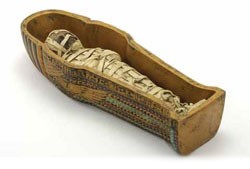Science Exposes Mummies' Secrets

By Patricia Rogler
Mummies, preserved bodies usually encased in wrappings, have long been a mystery to scientists. Although mummies contain important scientific information, until now, it has been impossible to probe their secrets without destroying these ancient relics. Thanks to the development of new scientific technology, like computerized tomography (CT) scans and endoscopes, scientists are finally uncovering the secrets held within the mummies and their wrappings.
The Mysterious Pa-lb
Legend has it that the mummy of a bird is contained inside a 4,000-year-old Egyptian human mummy, which was part of the collection at the Barnum Museum in Bridgeport, Conn. No one knew much about this mummy other than that it was believed to be a man, and that its name was Pa-lb (pronounced pie eeb). For years it had been impossible for scientists to discover the truth about this mummy without unwrapping it. However, due to the invention of the CT scanner, that has all changed. When scientists put the mummy through this scanner, they discovered that it was, in fact, the mummy of a woman, and it did not contain a bird.
Ötzi's Final Meal
One of the oldest mummies in the world, Ötzi, was discovered in the Italian Alps. His corpse was naturally mummified about 5,000 years ago by snow and ice. Scientists wanted to examine the contents of his stomach, but could not find it. Recently, they were able to put the mummy through a CT scanner and were able to locate the stomach, which was found in his upper torso. The scientists believe it had slipped upwards because he was found lying over a rock. Surprisingly, they discovered that his stomach was completely full. After extracting a tiny sample of its contents for DNA testing, the scientists identified his last meal as being an Alpine ibex, a type of mountain goat.
With the help of high-tech lab equipment, like CT scanners and endoscopes, scientists are making remarkable discoveries that have broadened our understanding of ancient life. The analysis of mummies using this new equipment can help us know what our ancestors ate, how they lived and what they valued. There are still more mysteries to unlock, but scientists are taking the first steps to exposing the mummies' secrets.
Classroom Discussion
- In what ways can discovering more about mummies help our understanding of ancient life?
- What is the difference between a naturally mummified and an artificially mummified corpse? What valuable information can each offer to science?
